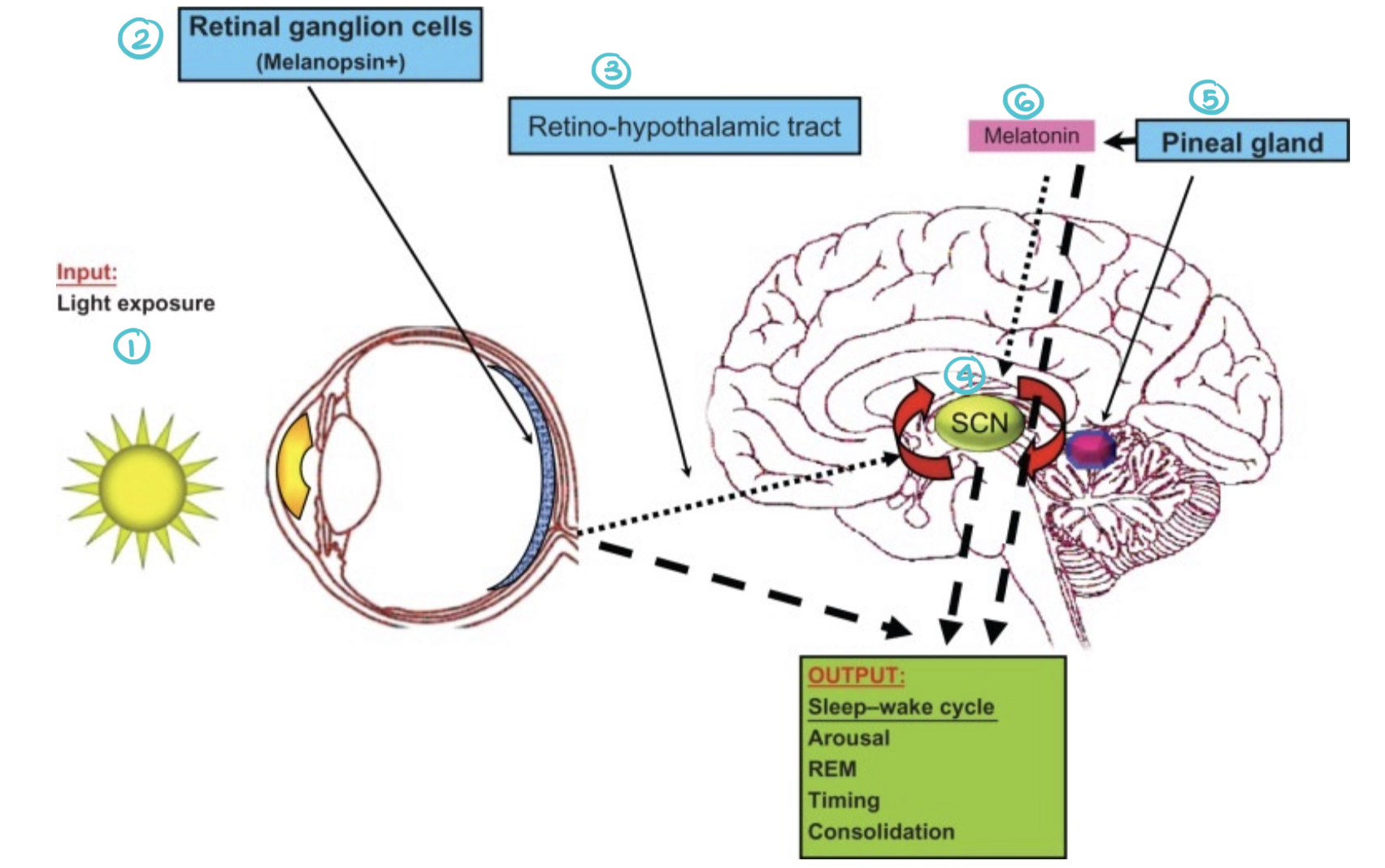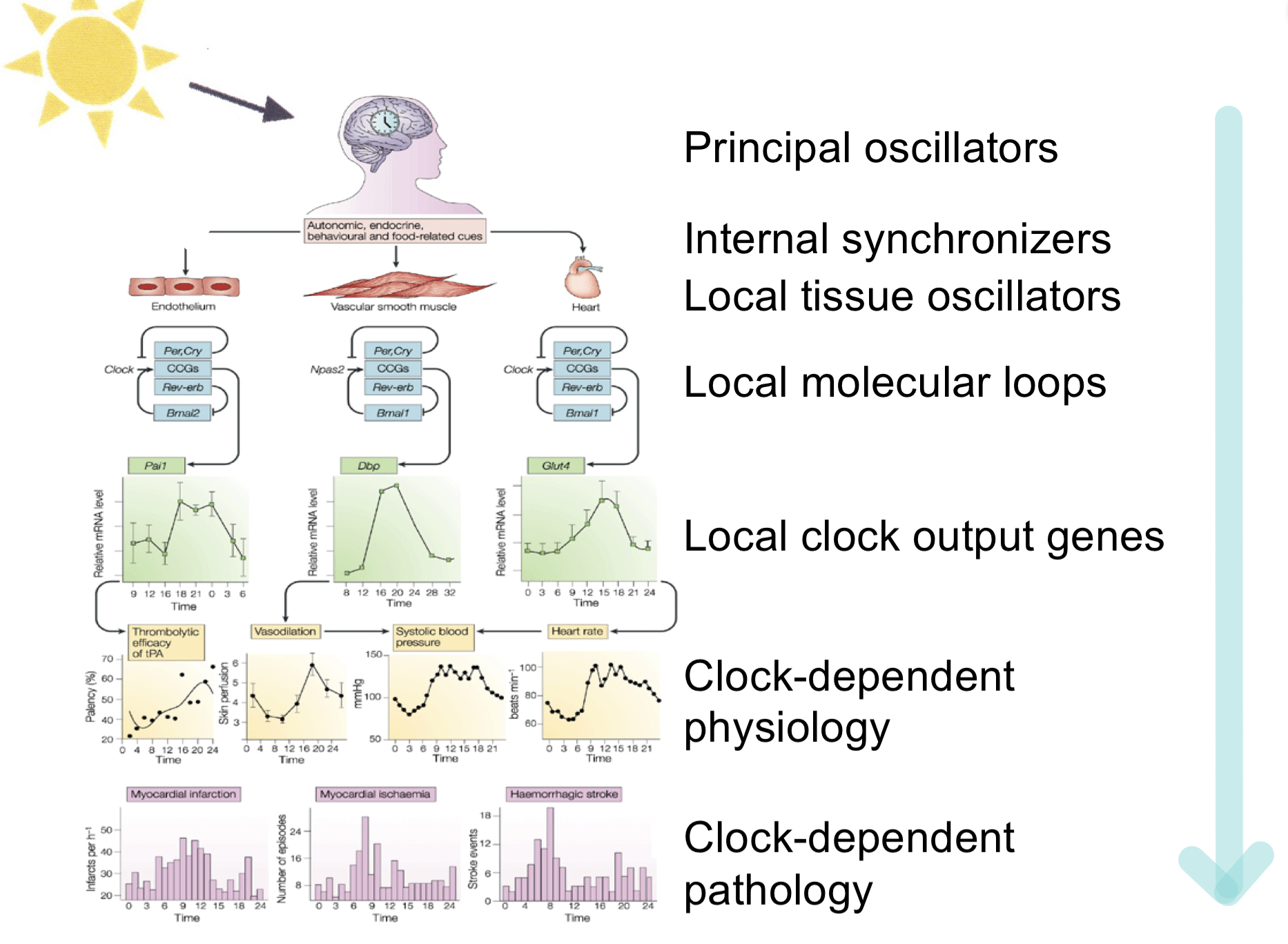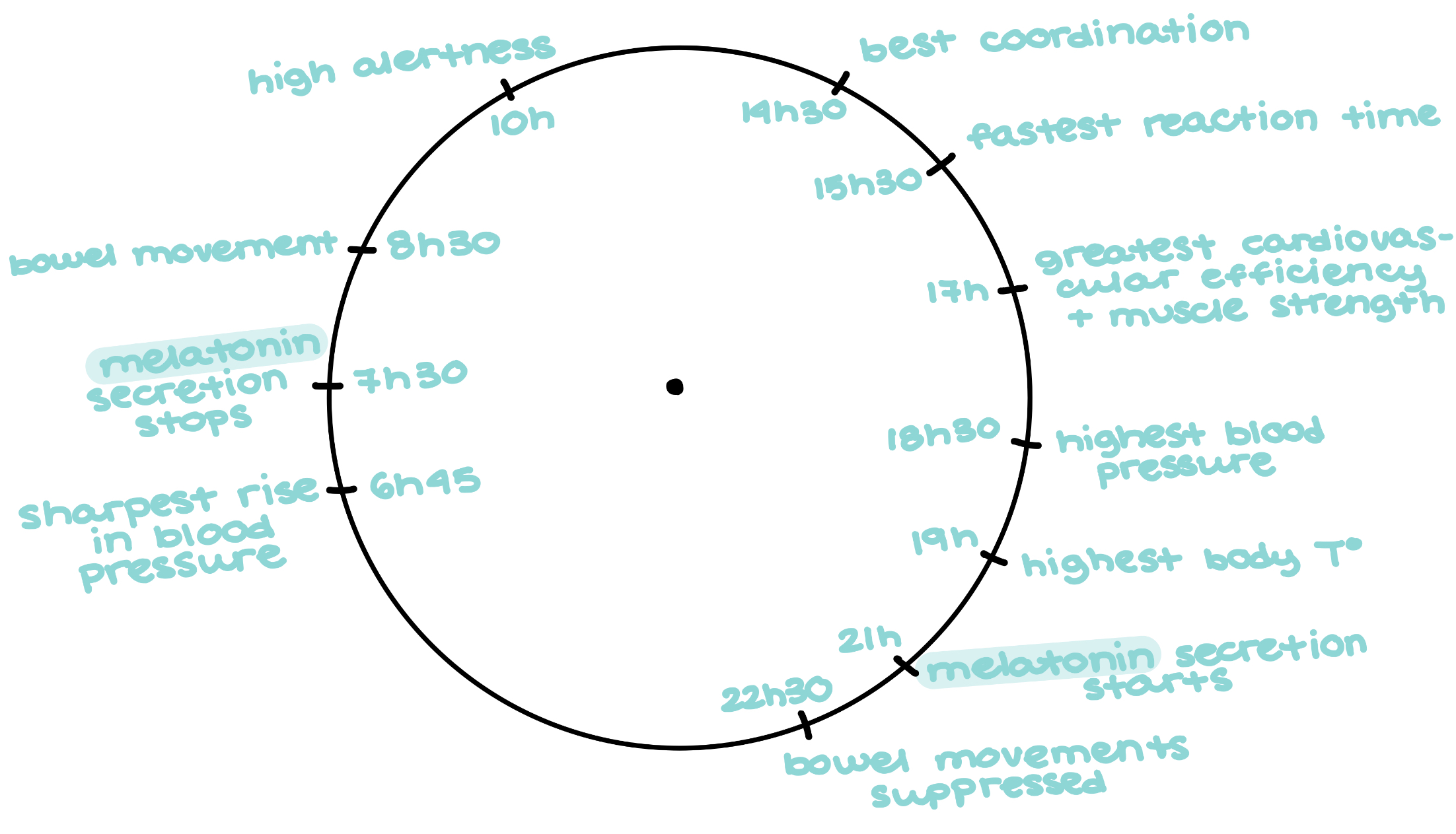
Lecture 5
Ultradian Process
Less than 24h
Consists of sleep architecture
Is modulated by circadian and homeostatic processes
Sleep stages are differently distributed during early and late night
Circadian Rhythm
Lasts about 1 day
Rhythm of living organisms
Dynamic balance between stability of the system and adaptability to demands of the environment
Balance between modulation of internal organization and external
Circadian System
 SCN
SCN
SCN: main oscillator, the circadian master clock
It is synchronized by zeitgebers
If SCN is lesioned, the body’s oscillators become desynchronized
We can get very thirsty or hungry during the night and it leads to death in animals
Transplanting SCN into the hypothalamus restores rhythms to donor’s circadian phase
Non-Image Forming Visual System
Retinal Ganglion Cells
Characteristics:
Contain melanopsin: a light-sensitive protein
Control pupil dilation
Produces melatonin
Projects to SCN and VLPO
Retino-Hypothalamic Tract
Need higher intensity light than cones
After the light is off, it keeps firing for some time
IPRGC
Slow and progressive response to light
Because we go from light to darkness all the time in our environment
Blue Light
Blue light: stimulates retinal ganglion cells → SCN → pineal gland → supresses melatonin
Light Source | Melatonin Suppression |
|---|---|
LED bulb | 80% |
Incandescent bulb | 40% |
Candle | 2% |
Candle-light-style OLED | < 2% |
Hierarchical Organization

In Humans

Zeitgebers
Zeitgeber: meaning time giver
Participate in circadian entrainment
Their effect depends on the circadian phase of the organism
Principal Zeitgebers ranked from most important to less important
Light
Food
Activity-rest patterns
Social cues (ex: everyone going to sleep)
Melatonin
Characteristics:
Hormone secreted by the pineal gland
Acts on the SCN
Stimulated by darkness and suppressed by light
Has an opposing action with cortisol
Has different seasonal patterns:
Summer = less melatonin produced
Winter = more melatonin produced
Correlated with body temperature, blood pressure, and growth hormone
Functions:
Regulates breeding patterns in animals
Involved in immune function
General Information
In Canada, we sleep more in the winter
Our biological rhythms are adapted to our planetary movement (day/night)
If we go to sleep at 5 A.M., we will have a hard time going to sleep in the evening because our circadian rhythm tells us to sleep but our homeostatic pressure is low
Many organs and peripheral tissues have their own circadian clocks but they are subordinate to the SCN
At 6 A.M., we have a lot of cortisol and melatonin so that we can be able to wake up eventually
Cortisol increases in the morning so it could be an explanation for nightmares
Sleep is really susceptible to the placebo effect
When the circadian phase is shifted by an advance or delay in light exposure, there is a gradual adaptation over a few days
Lecture 5
Ultradian Process
Less than 24h
Consists of sleep architecture
Is modulated by circadian and homeostatic processes
Sleep stages are differently distributed during early and late night
Circadian Rhythm
Lasts about 1 day
Rhythm of living organisms
Dynamic balance between stability of the system and adaptability to demands of the environment
Balance between modulation of internal organization and external
Circadian System
 SCN
SCN
SCN: main oscillator, the circadian master clock
It is synchronized by zeitgebers
If SCN is lesioned, the body’s oscillators become desynchronized
We can get very thirsty or hungry during the night and it leads to death in animals
Transplanting SCN into the hypothalamus restores rhythms to donor’s circadian phase
Non-Image Forming Visual System
Retinal Ganglion Cells
Characteristics:
Contain melanopsin: a light-sensitive protein
Control pupil dilation
Produces melatonin
Projects to SCN and VLPO
Retino-Hypothalamic Tract
Need higher intensity light than cones
After the light is off, it keeps firing for some time
IPRGC
Slow and progressive response to light
Because we go from light to darkness all the time in our environment
Blue Light
Blue light: stimulates retinal ganglion cells → SCN → pineal gland → supresses melatonin
Light Source | Melatonin Suppression |
|---|---|
LED bulb | 80% |
Incandescent bulb | 40% |
Candle | 2% |
Candle-light-style OLED | < 2% |
Hierarchical Organization

In Humans

Zeitgebers
Zeitgeber: meaning time giver
Participate in circadian entrainment
Their effect depends on the circadian phase of the organism
Principal Zeitgebers ranked from most important to less important
Light
Food
Activity-rest patterns
Social cues (ex: everyone going to sleep)
Melatonin
Characteristics:
Hormone secreted by the pineal gland
Acts on the SCN
Stimulated by darkness and suppressed by light
Has an opposing action with cortisol
Has different seasonal patterns:
Summer = less melatonin produced
Winter = more melatonin produced
Correlated with body temperature, blood pressure, and growth hormone
Functions:
Regulates breeding patterns in animals
Involved in immune function
General Information
In Canada, we sleep more in the winter
Our biological rhythms are adapted to our planetary movement (day/night)
If we go to sleep at 5 A.M., we will have a hard time going to sleep in the evening because our circadian rhythm tells us to sleep but our homeostatic pressure is low
Many organs and peripheral tissues have their own circadian clocks but they are subordinate to the SCN
At 6 A.M., we have a lot of cortisol and melatonin so that we can be able to wake up eventually
Cortisol increases in the morning so it could be an explanation for nightmares
Sleep is really susceptible to the placebo effect
When the circadian phase is shifted by an advance or delay in light exposure, there is a gradual adaptation over a few days
 Knowt
Knowt
